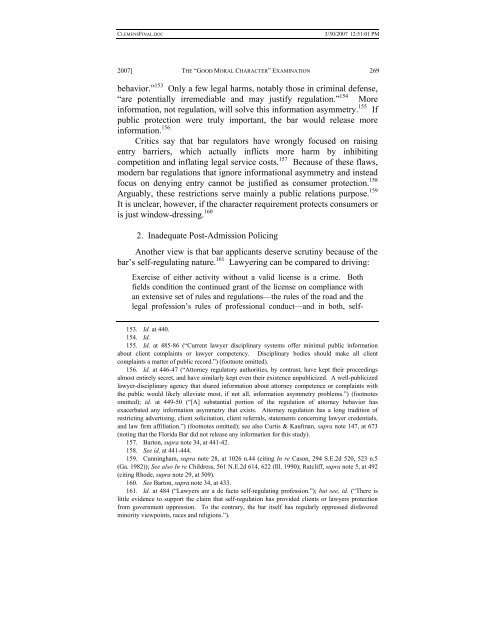Facing the Klieg Lights: Understanding the "Good Moral Character"
Facing the Klieg Lights: Understanding the "Good Moral Character"
Facing the Klieg Lights: Understanding the "Good Moral Character"
You also want an ePaper? Increase the reach of your titles
YUMPU automatically turns print PDFs into web optimized ePapers that Google loves.
CLEMENSFINAL.DOC<br />
3/30/2007 12:51:01 PM<br />
2007] THE “GOOD MORAL CHARACTER” EXAMINATION 269<br />
behavior.” 153 Only a few legal harms, notably those in criminal defense,<br />
“are potentially irremediable and may justify regulation.” 154 More<br />
information, not regulation, will solve this information asymmetry. 155 If<br />
public protection were truly important, <strong>the</strong> bar would release more<br />
information. 156<br />
Critics say that bar regulators have wrongly focused on raising<br />
entry barriers, which actually inflicts more harm by inhibiting<br />
competition and inflating legal service costs. 157 Because of <strong>the</strong>se flaws,<br />
modern bar regulations that ignore informational asymmetry and instead<br />
focus on denying entry cannot be justified as consumer protection. 158<br />
Arguably, <strong>the</strong>se restrictions serve mainly a public relations purpose. 159<br />
It is unclear, however, if <strong>the</strong> character requirement protects consumers or<br />
is just window-dressing. 160<br />
2. Inadequate Post-Admission Policing<br />
Ano<strong>the</strong>r view is that bar applicants deserve scrutiny because of <strong>the</strong><br />
bar’s self-regulating nature. 161 Lawyering can be compared to driving:<br />
Exercise of ei<strong>the</strong>r activity without a valid license is a crime. Both<br />
fields condition <strong>the</strong> continued grant of <strong>the</strong> license on compliance with<br />
an extensive set of rules and regulations—<strong>the</strong> rules of <strong>the</strong> road and <strong>the</strong><br />
legal profession’s rules of professional conduct—and in both, self-<br />
153. Id. at 440.<br />
154. Id.<br />
155. Id. at 485-86 (“Current lawyer disciplinary systems offer minimal public information<br />
about client complaints or lawyer competency. Disciplinary bodies should make all client<br />
complaints a matter of public record.”) (footnote omitted).<br />
156. Id. at 446-47 (“Attorney regulatory authorities, by contrast, have kept <strong>the</strong>ir proceedings<br />
almost entirely secret, and have similarly kept even <strong>the</strong>ir existence unpublicized. A well-publicized<br />
lawyer-disciplinary agency that shared information about attorney competence or complaints with<br />
<strong>the</strong> public would likely alleviate most, if not all, information asymmetry problems.”) (footnotes<br />
omitted); id. at 449-50 (“[A] substantial portion of <strong>the</strong> regulation of attorney behavior has<br />
exacerbated any information asymmetry that exists. Attorney regulation has a long tradition of<br />
restricting advertising, client solicitation, client referrals, statements concerning lawyer credentials,<br />
and law firm affiliation.”) (footnotes omitted); see also Curtis & Kaufman, supra note 147, at 673<br />
(noting that <strong>the</strong> Florida Bar did not release any information for this study).<br />
157. Barton, supra note 34, at 441-42.<br />
158. See id. at 441-444.<br />
159. Cunningham, supra note 28, at 1026 n.44 (citing In re Cason, 294 S.E.2d 520, 523 n.5<br />
(Ga. 1982)); See also In re Childress, 561 N.E.2d 614, 622 (Ill. 1990); Ratcliff, supra note 5, at 492<br />
(citing Rhode, supra note 29, at 509).<br />
160. See Barton, supra note 34, at 433.<br />
161. Id. at 484 (“Lawyers are a de facto self-regulating profession.”); but see, id. (“There is<br />
little evidence to support <strong>the</strong> claim that self-regulation has provided clients or lawyers protection<br />
from government oppression. To <strong>the</strong> contrary, <strong>the</strong> bar itself has regularly oppressed disfavored<br />
minority viewpoints, races and religions.”).
















